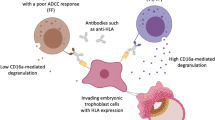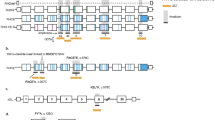Abstract
A line of investigations indicate that genes in the human leukocyte antigen (HLA) complex are involved in a successful acceptance of the semiallogeneic fetus during pregnancy. In this study, associations between specific HLA class Ia (HLA-A and -B) and class II (HLA-DRB1, -DQA1, -DQB1, -DPA1 and -DPB1) alleles and the risk of developing severe preeclampsia/eclampsia were investigated in a detailed and large-scale study. In total, 259 women diagnosed with severe preeclampsia or eclampsia and 260 matched control women with no preeclampsia, together with their neonates, were included in the study. HLA genotyping for mothers and neonates was performed using next-generation sequencing. The HLA-DPB1*04:01:01G allele was significantly more frequent (Pc=0.044) among women diagnosed with severe preeclampsia/eclampsia compared with controls, and the DQA1*01:02:01G allele frequency was significantly lower (Pc=0.042) among newborns born by women with severe preeclampsia/eclampsia compared with controls. In mothers with severe preeclampsia/eclampsia, homozygosity was significantly more common compared with controls at the HLA-DPB1 locus (Pc=0.0028). Although the current large study shows some positive results, more studies, also with a functional focus, are needed to further clarify a possible role of the classical HLA genes in preeclampsia.
This is a preview of subscription content, access via your institution
Access options
Subscribe to this journal
Receive 6 digital issues and online access to articles
$119.00 per year
only $19.83 per issue
Buy this article
- Purchase on Springer Link
- Instant access to full article PDF
Prices may be subject to local taxes which are calculated during checkout
Similar content being viewed by others
References
Duley L . The global impact of pre-eclampsia and eclampsia. Semin Perinatol 2009; 33: 130–137.
Steegers EP, von Dadlelszen P, Duvekot JJ, Pijnenborg R . Pre-eclampsia. Lancet 2010; 376: 631–644.
Dekker G, Robillard PY . Pre-eclampsia: is the immune maladaptation hypothesis still standing? An epidemiological update. J Reprod Immunol 2007; 76: 8–16.
Redman CWG, Sargent IL . Immunology of pre-eclampsia. Am J Reprod Immunol 2010; 63: 534–543.
Saftlas AF, Beydoun H, Triche E . Immunogenetic determinants of preeclampsia and related pregnancy disorders: a systematic review. Obstet Gynecol 2005; 106: 162–172.
Larsen MH, Hylenius S, Andersen AM, Hviid TV . The 3’UTR-untranslated region of the HLA-G gene in relation to pre-eclampsia: revisited. Tissue Antigens 2010; 75: 253–261.
Hylenius S, Andersen AM, Melbye M, Hviid TV . Association between HLA-G genotype and risk of pre-eclampsia: a case-control study using family triads. Mol Hum Reprod 2004; 10: 237–246.
Dahl M, Djurisic S, Hviid TV . The many faces of human leukocyte antigen-G: relevance to the fate of pregnancy. J Immunol Res 2014; 2014: 591489.
Hviid TV, Hylenius S, Rørbye C, Nielsen LG . HLA-G allelic variants are associated with differences in the HLA-G mRNA isoform profile and HLA-G mRNA levels. Immunogenetics 2003; 55: 63–79.
Hackmon R, Koifman A, Hyodo H, Glickman H, Sheiner E, Geraghty DE . Reduced third-trimester levels of soluble human leukocyte antigen G protein in severe preeclampsia. Am J Obstet Gynecol 2007; 197: 255.e1–5.
Honda K, Takakuwa K, Hataya I, Yasuda M, Kurabayashi T, Tanaka K . HLA-DQB1 and HLA-DPB1 genotypes in severe preeclampsia. Obstet Gynecol 2000; 96: 385–389.
Omu AE, al-Qattan F, Bukhadour N . Human leucocyte antigens in pregnant women with pre-eclampsia associated with intrauterine growth retardation and in normal controls. Arch Gynecol Obstet 1998; 261: 129–137.
Carreiras M, Montagnani S, Layrisse Z . Preeclampsia: a multifactorial disease resulting from the interaction of the feto-maternal HLA genotype and HCMV infection. Am J Reprod Immunol 2002; 48: 176–183.
Takakuwa K, Arakawa M, Tamura M, Hataya I, Higashino M, Yasuda M et al. HLA antigens in patients with severe preeclampsia. J Perinat Med 1997; 25: 79–83.
Biggar RJ, Poulsen G, Ng J, melbye M, Boyd HA . HLA antigen sharing between mother and fetus as a risk factor for eclampsia and preeclampsia. Hum Immunol 2010; 71: 263–267.
Kilpatrick DC, Liston WA, Gibson F, Livingstone J . Association between susceptibility to pre-eclampsia within families and HLA DR4. Lancet 1989; 2: 1063–1065.
Hoff C, Stevens RG, Mendenhall H, Peterson RD, Spinnato JA . Association between risk for pre-eclampsia and HLA DR4. Lancet 1990; 335: 660–661.
De Luca Brunori I, Battini L, Simonelli M, Clemente F, Brunori E, Mariotti ML et al. Increased HLA-DR homozygosity associated with pre-eclampsia. Hum Reprod 2000; 15: 1807–1812.
De Luca Brunori I, Battini L, Simonelli M, Brunori E, Valentino V, Curico M et al. HLA-DR in couples associated with preeclampsia: background and updating by DNA sequencing. J Reprod Immunol 2003; 59: 235–243.
Kilpatrick DC, Liston WA, Jazwinska EC, Smart GE . Histocompatibility studies in pre-eclampsia. Tissue Antigens 1987; 29: 232–236.
Athanassakis I, Aifantis Y, Makrygiannakis A, Koumantakis E, Vassiliadis S . Placental tissue from human miscarriages expresses class II HLA-DR antigens. Am J Reprod Immunol 1995; 34: 281–287.
Redman CW, Bodmer JG, Bodmer WF, Beilin LJ, Bonnar J . HLA antigens in severe pre-eclampsia. Lancet 1978; 2: 397–399.
Triche EW, Harland KK, Field EH, Rubenstein LM, Saftlas AF . Maternal-fetal HLA sharing and preeclampsia: variation in effects by seminal fluid exposure in a case-control study of nulliparous women in Iowa. J Reprod Immunol 2014; 101-102: 111–119.
Hoff C, Peevy K, Giattina K, Spinnato JA, Peterson RD . Maternal-fetal HLA-DR relationships and pregnancy-induced hypertension. Obstet Gynecol 1992; 80: 1007–1012.
Schneider K, Knutson F, Tamsen L, Sjöberg O . HLA antigen sharing in preeclampsia. Gynecol Obstet Invest 1994; 37: 87–90.
Hviid TV, Larsen LG, Hoegh AM, Bzorek M . HLA-G expression in placenta in relation to HLA-G genotype and polymorphisms. Am J Reprod Immunol 2004; 52: 212–217.
Moreau P, Contu L, Alba F, Lai S, Simoes R, Orrù S et al. HLA-G gene polymorphism in human placentas: possible association of G*0106 allele with preeclampsia and miscarriage. Biol Reprod 2008; 79: 459–467.
Tubbergen P, Lachmeijer AM, Althuisius SM, Vlak ME, van Geijn HP, Dekker GA . Change in paternity: a risk factor for preeclampsia in multiparous women? J Reprod Immunol 1999; 45: 81–88.
Trogstad LI, Eskild A, Magnus P, Samuelsen SO, Nesheim BI . Changing paternity and time since last pregnancy; the impact on pre-eclampsia risk. A study of 547 238 women with and without previous pre-eclampsia. Int J Epidemiol 2001; 30: 1317–1322.
Dekker G . The partner’s role in the etiology of preeclampsia. J Reprod Immunol 2002; 57: 203–215.
Dekker G, Robillard PY . Preeclampsia: a couple’s disease with maternal and fetal manifestations. Curr Pharm Des 2005; 11: 699–710.
Misaghi S, Sun ZY, Stern P, Gaudet R, Wagner G, Ploegh H . Structural and functional analysis of human cytomegalovirus US3 protein. J Virol 2004; 78: 413–423.
Saftlas AF, Rubenstein L, Prater K, Harland KK, Field E, Triche EW . Cumulative exposure to paternal seminal fluid prior to conception and subsequent risk of preeclampsia. J Reprod Immunol 2014; 101-102: 104–110.
Koelman CA, Coumans AB, Nijman HW, Doxiadis II, Dekker GA, Claas FH . Correlation between oral sex and a low incidence of preeclampsia: a role for soluble HLA in seminal fluid? J Reprod Immunol 2000; 46: 155–166.
Nelson WC, Pyo CW, Vogan D, Wang R, Pyon YS, Hennessey C et al. An integrated genotyping approach for HLA and other complex genetic systems. Hum Immunol 2015; 76: 928–938.
Holm S . A simple sequentially rejective multiple test procedure. Scand J Stat 1979; 6: 65–70.
Acknowledgements
Support for this work was generously provided by The Region Zealand Health Sciences Research Foundation.
Author information
Authors and Affiliations
Corresponding author
Ethics declarations
Competing interests
The authors declare no conflict of interest.
Rights and permissions
About this article
Cite this article
Emmery, J., Hachmon, R., Pyo, C. et al. Maternal and fetal human leukocyte antigen class Ia and II alleles in severe preeclampsia and eclampsia. Genes Immun 17, 251–260 (2016). https://doi.org/10.1038/gene.2016.20
Received:
Revised:
Accepted:
Published:
Issue Date:
DOI: https://doi.org/10.1038/gene.2016.20
This article is cited by
-
Association between HLA-A gene polymorphism and early-onset preeclampsia in Chinese pregnant women early-onset
BMC Pregnancy and Childbirth (2020)
-
Epigenome-wide DNA methylation profiling of preeclamptic placenta according to severe features
Clinical Epigenetics (2020)



